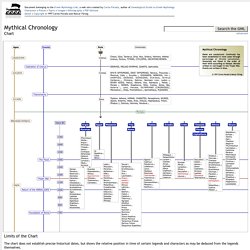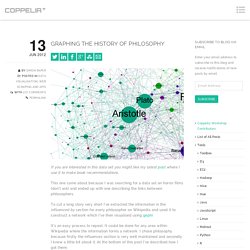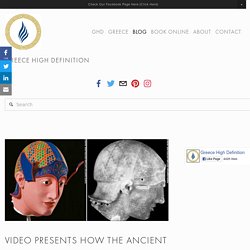

My Abilitator. Lascaux. Guide learn Egyptian Hieroglyphic symbols Rosetta Stone translate. To understand is to equal Raphael Early representation As early human settlements developed and were able to support non-agricultural specialization, a method was required to record basic information.

Typically this occurred within the frameworks of religion and government. Records were kept of inventory on tablets. Strokes for the number with pictures ('pictograms') of an animal or object. Early civilisations were often sited near principal rivers and the indigenous reeds frequently used to mark clay tablets. Mythical Chronology. Limits of the Chart The chart does not establish precise historical dates, but shows the relative position in time of certain legends and characters as may be deduced from the legends themselves.

Immortals. Philprettyv4. Graphing the History of Philosophy. A Zoomable Graph of the History of Philosophy. The History Of Philosophy. A Quick History of Philosophy - General. Pre-Socratic Philosophy | Classical Philosophy | Other Ancient Philosophical Schools | Medieval Philosophy | Early Modern Philosophy | 19th Century Philosophy | 20th Century Philosophy For younger readers and those with short attention spans, here is my own abbreviated and simplified history of Western Philosophy, all on one (long) page.

The explanations are necessarily simplistic and lacking in detail, though, and the links should be followed for more information. Graphing the history of philosophy. A close up of ancient and medieval philosophy ending at Descartes and Leibniz If you are interested in this data set you might like my latest post where I use it to make book recommendations.

This one came about because I was searching for a data set on horror films (don’t ask) and ended up with one describing the links between philosophers. To cut a long story very short I’ve extracted the information in the influenced by section for every philosopher on Wikipedia and used it to construct a network which I’ve then visualised using gephi It’s an easy process to repeat. It could be done for any area within Wikipedia where the information forms a network. Philosophy for children: the why and the how - The Philosopher's Zone - ABC Radio National. Human nature: Ancient Philosophy. Mark Pagel: How language transformed humanity. History of linguistics. Linguistics, as a study, endeavors to describe and explain the human faculty of language.

Linguistic study was originally motivated by the correct description of classical liturgical language, notably that of Sanskrit grammar, or by the development of logic and rhetoric in ancient Greece, leading to a grammatical tradition in Hellenism. Beginning around the 4th century BCE, China also developed its own grammatical traditions. Goddesses of antiquity offer Moses a path away from patriarchy – via funk and soul. Aeon email newsletters are issued by the not-for-profit, registered charity Aeon Media Group Ltd (Australian Business Number 80 612 076 614).

This Email Newsletter Privacy Statement pertains to the personally identifying information you voluntarily submit in the form of your email address to receive our email newsletters More generally, when visiting the Aeon site you should refer to our site Privacy Policy here. This Email Newsletter Privacy Statement may change from time to time and was last revised 5 June, 2018. Heraclitus - The Fragments. TEMSELING 1. Antikythera - At the belated St Patrick’s Day dinner I attended last week there was an interesting guest: Michael Wright, a mechanical engineer, although that hardly does him justice.

We have to go back some way to understand his achievement, in fact to Antikythera in the Aegean in about 80 BC where a cargo vessel carrying booty from Rhodes to Rome – for Julius Caesar – was wrecked. It lay undiscovered on the seabed until some sponge divers found it in 1900. There were many conventional artifacts such as bronze and marble statues, jewellery, pottery, glassware and coins but in addition some encrusted bronze cogwheels. Antikythera mechanism.
Ancient analog computer designed to calculate astronomical positions The Antikythera mechanism (Fragment A – front); visible is the largest gear in the mechanism, approximately 14 centimetres (5.5 in) in diameter The Antikythera mechanism (Fragment A – back) The Antikythera mechanism (, ) is an ancient hand powered Greek analogue computer[1] which has also been described as the first example of such device[2][3][4] used to predict astronomical positions and eclipses for calendar and astrological purposes decades in advance.[5][6][7] It could also be used to track the four-year cycle of athletic games which was similar to an Olympiad, the cycle of the ancient Olympic Games.[8][9][10] The device, housed in the remains of a 34 cm × 18 cm × 9 cm (13.4 in × 7.1 in × 3.5 in) wooden box, was found as one lump, later separated into three main fragments which are now divided into 82 separate fragments after conservation efforts.

Place Names in Gene Wolfe’s Soldier of the Mist – Ultan's Library. “Hundred Eyed,” “Redface Island,” — Gene Wolfe’s (1986) Soldier of the Mist is awash with charming place names that evoke wonder and puzzlement.

This essay uses the lens of toponymy, the formal study of place names, to explores how the protagonist Latro generates these intriguing and idiosyncratic labels. Introduction Noted toponymist George Stewart (1975) observed, Video Presents How The Ancient Greek Statues Really Looked. How The Ancient Greek Statues Really Looked?

Possibly Pretty Vibrant With Various Colors To most of us history enthusiasts, the phrase Classical Greece brings forth reveries of temples, sanctuaries and sculptures in their distinctly white marble facades. This notion perhaps has to do with the numerous extant ancient Greek specimens of structures (like the famed Parthenon), along with statues preserved in their ‘achromic’ forms in various museums around the globe.
The Meaning of khrónos in Ancient Greek: A Diachronic Perspective. BibTeX Bookmark OpenURL Abstract The present paper deals with the semantics of the polysemous lexeme khrónos across various stages in Ancient Greek. Ancient Greeks: Golden Age of Civilization. Anaximander of Miletus and His Philosophy on the Origin of All Things. Anaximander of Miletus was a Pre-Socratic philosopher who belonged to the Milesian school. As indicated by its name, this school of thought was based in the city of Miletus on the western coast of Anatolia, modern day Turkey. Anaximander is one of the three prominent figures in this philosophical school, the other two being Thales and Anaximenes, the former commonly thought to have been Anaximander’s teacher, whilst the latter, his student.
It has been pointed out that these three early philosophers held quite distinct views on most subjects, and that their grouping is based on geographical convenience rather than on shared opinions. Nevertheless, it may also be said that these philosophers focused on questions regarding nature (for example, what is the quintessential substance of the universe?) Which allows them to be grouped together. Anaximander is thought to have been born in 610 BC. Presocratic Philosophy. Pre-Socratic Philosophers Foreign Language Flashcards.
Logos. Logos (UK /ˈloʊɡɒs/, /ˈlɒɡɒs/, or US /ˈloʊɡoʊs/; Greek: λόγος, from λέγω lego "I say") is an important term in philosophy, psychology, rhetoric, and religion. Originally a word meaning "a ground", "a plea", "an opinion", "an expectation", "word", "speech", "account", "to reason"[1][2] it became a technical term in philosophy, beginning with Heraclitus (ca. 535–475 BC), who used the term for a principle of order and knowledge.[3] Plato's Cratylus. The formal topic of the Cratylus is ‘correctness of names’, a hot topic in the late fifth century BC when the dialogue has its dramatic setting. Sophists like Prodicus offered training courses in this subject, sometimes perhaps meaning by it little more than lessons in correct diction.
But that practical issue spawned the theoretical question, what criteria determine the correct choice of name for any given object? Tà mathémata: we can only learn what we already know. Antikythera mechanism: Ancient Greece's astronomy-based clock. Though it it seemed to be just a corroded lump of some sort when it was found in a shipwreck off the coast of Greece near Antikythera in 1900, in 1902 archaeologist Valerios Stais, looking at the gear embedded in it, guessed that what we now call the “Antikythera mechanism” was some kind of astronomy-based clock.
How Ancient Greek Statues Really Looked: Research Reveals their Bold, Bright Colors and Patterns. A Translator’s Reckoning With the Women of the Odyssey. Where Computer Science Meets Greek Philosophy. The rise and fall and rise of logic. The history of logic should be of interest to anyone with aspirations to thinking that is correct, or at least reasonable. This story illustrates different approaches to intellectual enquiry and human cognition more generally. Reflecting on the history of logic forces us to reflect on what it means to be a reasonable cognitive agent, to think properly. Is it to engage in discussions with others? Greek Philosophical Terms. TEMSELING 2. Latin Poetry Podcast. Abracadabra mortiferum magis est quod Graecis hemitritaeos vulgatur verbis; hoc nostrā dicere linguā non potuēre ulli, puto, nec voluere parentes. inscribes chartae quod dicitur abracadabra saepius et subter repetes, sed detrahe summam et magis atque magis desint elementa figuris singula, quae semper rapies, et cetera figes, donec in angustum redigatur littera conum : his lino nexis collum redimire memento. nonulli memorant adipem prodesse leonis.
Roman Influence on Western Civilization. Western civilization is what is presently called modern or contemporary society that mainly comprises Western Europe and North America. Philosophical Latin Phrases. Lorem Ipsum Generator. Philosophy: Latin terms with English translations. It would is a nearly impossible task to come up with a comprehensive dictionary of Latin terms used in any particular setting. Philosophical Latin is highly technical and individual philosophers often adapted existing terms for their own needs. Still, it is my hope that this wordlist will be useful to someone just starting to read philosophic works in the original Latin. M. Fabi Quintiliani institutionis oratoriae liber decimus by Quintilianus.
The Roman Way. Romanitas, in Nova Roma, refers to the general study and practice of Roman culture. Ancient Roman Philosophy. Internet Encyclopedia of Philosophy. Ancient Rome - Ancient History. Skepticism: From Antiquity to the Present: Diego Machuca: Bloomsbury Academic. 5: Medieval Philosophy. Revisioning Medieval Rhetoric. Black Death and the Late Middle Ages. The Black Death by lordgrizzly. European Middle Ages To Renaissance Timeline. Correspondence Theory of Truth. Pathemata. Ancient Definitions of Rhetoric. Medievalists.net - Where the Middle Ages Begin. TEMSELING OUTLINE 1 (homework) Scholastic philosophy - Recherche Google. Black Death and the Late Middle Ages. Research Reveals More Complete Picture of the Devastation Wrought by the Black Death. Ancient and Philosophy of Medieval Language - Words And Things: Plato And Aristotle, Sentences And Facts: Aristotle And The Stoics, Abelard And The Early Middle Ages.
European Middle Ages To Renaissance Timeline. Pathemata. Medieval Semiotics. Scholasticism old and new; an introduction to scholastic philosophy, medieval and modern : Wulf, M. de (Maurice), 1867-1947. Le Nom De La Rose: MAKING OF. EOW: Modern - Old English Translator. After Umberto Eco was invited to submit a short detective story to a magazine, he instead wrote his first novel, “The Name of the Rose" TEMSELING 3. Theconcourse.deadspin. Illuminating the Renaissance - A time line of European events from 1400 to 1550. Linear Perspective in Renaissance Art: Definition & Example Works - Video & Lesson Transcript. Early Applications of Linear Perspective (article) Linear Perspective: Brunelleschi’s Experiment – Smarthistory. Time. Renaissance Writers and their works flashcards. The renaissance & language change. A Renaissance Timeline With Key Dates and Events.
Virtual Tour of Uffizi Gallery. A Renaissance Timeline With Key Dates and Events. Renaissance: Historical Background. BRUNELLESCHI and the Re-Discovery of Linear Perspective. Geometry in Art & Architecture Unit 11. Inferno de dante. Early Applications of Linear Perspective (article) 3 Characteristics of Renaissance Art That Changed the World. MA VS REN (class activity) RENABLOOM (class activity) Renaissance literature, authors and poets - Arts Online. Exhibits Collection. Dante’s Nine Circles of Hell, Reimagined for Linguistic Transgressions. Inferno - truthincharity.comtruthincharity.com. Inferno. Glorious Revolution. Aeon. ENLIGHTENMENT : The Age of Reason and Science. Enlightenment. Enlightenment - Facts & Summary. All About the Enlightenment The Age of Reason.